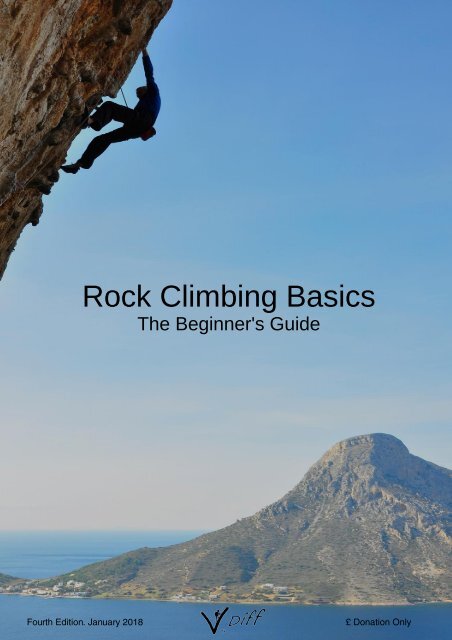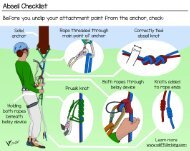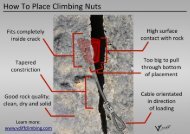Rock Climbing Basics - VDiff Climbing
This e-book will teach you how to: - Use basic climbing gear - Tie into the rope - Belay (lead and top rope) - Climb efficiently - Understand fall potential Plus much more. Further information: * Perfect for those who want to start rock climbing. * 100+ accurately drawn, full-colour illustrations. * Strong emphasis on climbing safety. * 63 information-packed pages. * Updated December 2017
This e-book will teach you how to:
- Use basic climbing gear
- Tie into the rope
- Belay (lead and top rope)
- Climb efficiently
- Understand fall potential
Plus much more.
Further information:
* Perfect for those who want to start rock climbing.
* 100+ accurately drawn, full-colour illustrations.
* Strong emphasis on climbing safety.
* 63 information-packed pages.
* Updated December 2017
Create successful ePaper yourself
Turn your PDF publications into a flip-book with our unique Google optimized e-Paper software.
<strong>Rock</strong> <strong>Climbing</strong> <strong>Basics</strong><br />
The Beginner's Guide<br />
Fourth Edition. January 2018<br />
£ Donation Only
Contents<br />
Introduction 4<br />
Preparation 10<br />
Top Rope <strong>Climbing</strong> 25<br />
Lead <strong>Climbing</strong> 39<br />
General 53<br />
Learn more: www.vdiffclimbing.com 3
The <strong>Climbing</strong> Harness<br />
Gear Loops<br />
These are for clipping gear<br />
to, such as quickdraws.<br />
This way, you can take<br />
gear with you as you climb.<br />
They're not strong enough<br />
to hold your weight, so<br />
never clip the rope into<br />
them.<br />
Buckle<br />
These can be used to<br />
adjust the size of your<br />
harness for a comfortable<br />
and tight fit. It's important<br />
that they are fastened<br />
correctly (see page 12).<br />
Waist Belt<br />
This fastens around the<br />
smallest part of your waist.<br />
Elastic<br />
These stretchy pieces of<br />
fabric help to stop your leg<br />
loops from sliding down at<br />
the back. They can be<br />
adjusted too.<br />
Leg Loops<br />
These fasten around the<br />
top of your thighs.<br />
Belay Loop<br />
This super strong loop<br />
connects the waist belt to<br />
the leg loops. You use it to<br />
belay from (more on this<br />
later).<br />
Learn more: www.vdiffclimbing.com<br />
7
How To Tie In To a <strong>Climbing</strong> Rope<br />
You'll need to tie the end of the rope to<br />
your harness before you climb. The best<br />
way to do this is using a rethreaded figure<br />
of 8 knot.<br />
It's really important that you do it correctly,<br />
as this knot is what connects you to the<br />
whole climbing system and keeps you<br />
safe.<br />
Step 1<br />
Make a loop about a meter<br />
from the end of the rope.<br />
Wrap the end of the rope<br />
around the base of the<br />
loop, then push the end<br />
through the loop.<br />
Step 2<br />
You should end up with an<br />
'8'. Make sure the knot is<br />
around 90cm from the end<br />
of the rope. The exact<br />
length varies with ropes of<br />
different diameters, but<br />
you'll soon get used to it.<br />
Step 3<br />
Pass the end of the rope<br />
through both of the two<br />
points on the front centre<br />
of your harness – the<br />
same ones your belay loop<br />
runs through. It is<br />
important that the rope<br />
goes through your harness<br />
in exactly the same way as<br />
your belay loop does.<br />
90cm<br />
Learn more: www.vdiffclimbing.com<br />
15
25cm<br />
Step 4<br />
Use the end of the rope to<br />
're-trace' the figure of 8<br />
knot. Follow the twists of<br />
the rope starting from<br />
where the rope joins your<br />
harness.<br />
Step 5<br />
Continue following the<br />
twists until you end up<br />
back at the start of the<br />
knot.<br />
Pull the whole thing tight.<br />
Step 6<br />
Make sure the end of the<br />
rope is around 25cm long.<br />
If it is shorter, you'll have to<br />
untie and start again. After<br />
this, you will need to tie a<br />
'stopper knot'. Loop the<br />
short section of rope<br />
around the main length.<br />
<strong>VDiff</strong> – <strong>Rock</strong> <strong>Climbing</strong> <strong>Basics</strong> > Preparation and Technique<br />
16
Step 7<br />
Do this twice, with the<br />
second loop closer to you<br />
than the first.<br />
Step 8<br />
Push the end of the rope<br />
through these two loops,<br />
away from you.<br />
Step 9<br />
Pull this tight too (make<br />
sure it's pushed right up<br />
against your figure of 8<br />
knot).<br />
If you didn't have enough rope left to tie a<br />
stopper knot, you'll need to retie the figure<br />
of 8 so that you do.<br />
It takes a bit of practise to judge just the<br />
right amount of rope from the start, but<br />
you'll get used to it soon.<br />
Learn more: www.vdiffclimbing.com<br />
17
<strong>Climbing</strong> Calls<br />
'<strong>Climbing</strong> calls' are certain words that<br />
climbers use so that everyone knows<br />
exactly what is happening, a bit like 'copy'<br />
or 'over' on a two-way radio.<br />
These calls may seem a bit excessive<br />
standing<br />
when you're standing next to each other at<br />
the wall, but they help to avoid any<br />
confusion when you're starting out. Once<br />
you're 50m away from each other outside<br />
and the wind is howling, you'll see why<br />
they're essential!<br />
When the climber is ready to climb, they<br />
tell the belayer to 'take in' the slack rope.<br />
The belayer pulls the rope through the<br />
belay device until it is tight on the climber.<br />
When the rope is tight, the climber tells the<br />
belayer 'that's me'. This lets the belayer<br />
know that the rope is tight on to the climber<br />
and not twisted or stuck anywhere else.<br />
When the belayer is ready to belay, they<br />
tell the climber they are 'on belay' and they<br />
can 'climb when ready'.<br />
Learn more: www.vdiffclimbing.com<br />
29
As a final check the climber tells the<br />
belayer they are 'climbing'. But the climber<br />
doesn't leave the ground until they hear<br />
'OK' from the belayer. Everything's good to<br />
go!<br />
If the climber wants a rest, they can tell the<br />
belayer to 'take'. The belayer holds the<br />
rope tight with both hands and replies 'OK'.<br />
If the climber wants to be lowered down at<br />
any point (or if they reach the top), they tell<br />
the belayer to 'lower'. The belayer replies<br />
'lowering'. They then lower the climber<br />
down.<br />
<strong>VDiff</strong> – <strong>Rock</strong> <strong>Climbing</strong> <strong>Basics</strong> > Top Rope <strong>Climbing</strong><br />
30
Good Belay Technique<br />
Ready to take in, give<br />
slack or lock off<br />
Rope fairly tight<br />
Hands correct distance<br />
away from belay device<br />
Tight grip on rope<br />
Holding the brake rope in<br />
the correct downwards<br />
direction<br />
Warning: Keep Hold Of The Rope<br />
When you belay you need to keep at least<br />
one hand on the brake rope all the time. It<br />
is this that stops the climber from falling to<br />
the ground.<br />
Letting go of the brake rope is like letting<br />
go of the steering wheel while driving on a<br />
fast country road.<br />
It's incredibly important that you pay<br />
constant attention when belaying and<br />
never let go of the brake rope!<br />
<strong>VDiff</strong> – <strong>Rock</strong> <strong>Climbing</strong> <strong>Basics</strong> > Top Rope <strong>Climbing</strong><br />
38
<strong>Rock</strong> <strong>Climbing</strong> <strong>Basics</strong>:<br />
Lead <strong>Climbing</strong><br />
Photographer: Sam Simpson
Warning: Back-Clipping<br />
The rope needs to be clipped through the<br />
quickdraw so that the end of the rope<br />
attached to you comes out of the front side<br />
of the quickdraw. If you fall, the rope will<br />
stay clipped through the carabiner.<br />
If you clip it the wrong way round, the rope<br />
could snap through the carabiner's gate if<br />
you fall. This would unclip the rope from<br />
the carabiner. This is known as 'back<br />
clipping'.<br />
If you're belaying a leader, keep an eye out<br />
for them accidentally back clipping, and let<br />
them know if they have!<br />
Warning: Cross-Loading<br />
Make sure your carabiners do not become<br />
'cross loaded' when you climb (loaded<br />
sideways). Also make sure the carabiner's<br />
gate has snapped shut after you've clipped<br />
the rope through it. Either of these will<br />
make your carabiner much weaker.<br />
Learn more about carabiner strength<br />
ratings:<br />
www.vdiffclimbing.com/basic-biners<br />
Learn more: www.vdiffclimbing.com<br />
43
Clipping The Top Anchor<br />
Once you get to the top of the wall, you'll<br />
need to clip the rope through the top<br />
anchor.<br />
Different walls have different systems for<br />
this – some have two snapgate<br />
carabiners, some have one or two<br />
screwgate carabiners that you'll need to<br />
unscrew first. Ask one of the staff before<br />
leading if in doubt!<br />
It's important to make sure that the anchor<br />
you clip does not have another rope<br />
already running through it. Having 2 ropes<br />
through the same anchor can damage<br />
them.<br />
Once you've clipped your rope through the<br />
top anchor, you can be lowered down in<br />
the same way as if you were top roping.<br />
However, if you've attached your own<br />
quickdraws on the way up, you'll need to<br />
collect them on the way down.<br />
Simply lower down, unclipping them from<br />
both the bolt and rope and then clipping<br />
them back to your gear loops. The belayer<br />
will need to stop lowering you at each bolt<br />
so you have time to do this.<br />
Pulling The Rope Down<br />
When you're pulling a lead rope down,<br />
shout 'rope' before it falls, so that everyone<br />
around you is expecting it – a falling rope<br />
in the head hurts!<br />
Make sure to pull the rope through so that<br />
the falling end drops down through the<br />
clipped quickdraws – this will slow it down<br />
and make it safer.<br />
<strong>VDiff</strong> – <strong>Rock</strong> <strong>Climbing</strong> <strong>Basics</strong> > Lead <strong>Climbing</strong><br />
44
Get the Full Version<br />
The full version of this e-book is available<br />
on a pay-what-you-want pricing system,<br />
starting at £0.<br />
You can download it for free, or show your<br />
support with a small donation.<br />
Get your copy here:<br />
https://gumroad.com/l/<strong>VDiff</strong><br />
Learn How To:<br />
- Use basic climbing gear<br />
- Tie into the rope<br />
- Belay (lead and top rope)<br />
- Climb efficiently<br />
- Understand fall potential<br />
Plus much more.<br />
Further Information:<br />
* Perfect for those who want to start rock<br />
climbing.<br />
* 100+ accurately drawn, full-colour<br />
illustrations.<br />
* Strong emphasis on climbing safety.<br />
* 63 information-packed pages.<br />
* Updated December 2017






